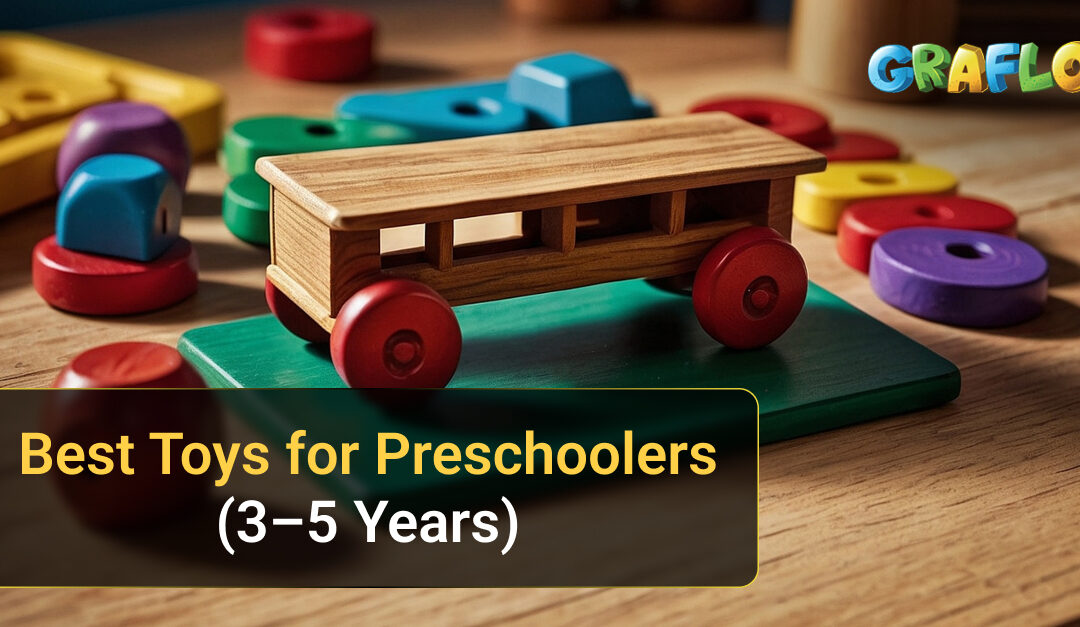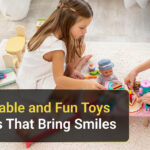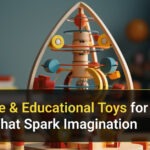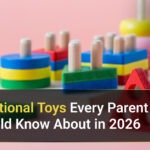Preschool years are a magical time. Between the ages of 3 to 5, children are full of curiosity, imagination, and an endless drive to explore their world. Every new experience, whether stacking blocks, pretending to cook, or solving a puzzle, helps develop vital skills for school and beyond. The right toys can play a key role in supporting this growth. Choosing the best preschool toys isn’t just about fun; it’s about encouraging creativity, critical thinking, and confidence through play.
In this guide, we’ll explore what makes a toy suitable for preschoolers, highlight the skills these toys nurture, and share some top recommendations that balance learning and enjoyment beautifully.
Understanding Preschool Development (Ages 3–5)
Preschoolers are in a stage of rapid development, both physically and mentally. Between ages 3 and 5, children start to:
- Develop stronger motor skills like running, climbing, and manipulating objects with better control.
- Improve language and communication, like expressing ideas, asking questions, and telling stories.
- Build social-emotional awareness, like learning to share, take turns, and cooperate.
- Develop problem-solving and imagination, engaging in pretend play and simple reasoning activities.
When choosing preschool toys, it’s important to match play experiences with these developmental milestones. A good toy should not only entertain but also promote exploration, creativity, and confidence.
What to Look for in Preschool Toys
Not all toys are created equal. Some light up, make sounds, and attract attention, but not all support learning effectively. When shopping for preschool toys, consider these qualities:
- Open-Ended Play: The best toys can be used in multiple ways. For example, building blocks allow endless creations rather than a single fixed outcome.
- Safety and Durability: Preschoolers love to test limits, so choose non-toxic, sturdy materials that can handle rough handling.
- Age Appropriateness: Toys should be challenging enough to engage but not so complex that they frustrate the child.
- Encouragement of Social Interaction: Cooperative games or playsets teach sharing and teamwork.
- Educational Value: Toys that teach basic math, colors, letters, or problem-solving lay the foundation for school readiness.
1. Building and Construction Toys
Few things spark creativity like construction play. Whether it’s classic wooden blocks or colorful interlocking pieces, these preschool toys encourage imagination, fine motor skills, and logical thinking. A simple tower can turn into a castle, bridge, or robot, whatever their imagination decides. This kind of play also sets the stage for future STEM learning, making it both fun and educational.
- Why They’re Great: Building activities help children understand shapes, balance, and cause-and-effect. They also promote patience and concentration.
- Examples: LEGO® DUPLO®, magnetic tile sets, and wooden building blocks.
2. Pretend Play Sets
At this age, pretend play, or “make-believe,” becomes central to how children understand the world. Dress-up clothes, kitchen sets, doctor kits, and toy vehicles let preschoolers imitate real-life roles. A child pretending to cook dinner or fix a broken toy is doing more than playing; they’re building social awareness and problem-solving skills. These preschool toys are invaluable for both solo and group play.
- Why They’re Great: Role-playing encourages empathy, creativity, and storytelling. It helps children process emotions and social scenarios.
- Examples: Play kitchens, puppet theaters, dollhouses, and toy tool sets.
3. Art and Craft Kits
Art activities allow preschoolers to express themselves and build fine motor coordination. Whether painting, molding clay, or cutting paper shapes, creative play helps boost confidence and focus. Simple activities like finger painting or coloring within lines introduce concepts like control and patience while letting kids freely explore their imagination.
- Why They’re Great: Arts and crafts enhance creativity, hand-eye coordination, and self-expression.
- Examples: Washable paints, crayons, playdough, and sticker books.
4. Educational and Learning Toys
Educational toys bridge the gap between fun and structured learning. They can introduce numbers, letters, shapes, and patterns in playful ways that feel natural, not forced. For instance, a counting bear set or a letter-matching puzzle helps kids recognize numbers and letters while building confidence in problem-solving. The key is to make learning feel like an adventure, not a lesson.
- Why They’re Great: These toys prepare preschoolers for academic readiness without pressure.
- Examples: Alphabet puzzles, counting games, sorting toys, and interactive storybooks.
5. Outdoor Toys and Active Play
Movement is essential for healthy growth. Outdoor play not only improves physical strength but also supports social and emotional development. Activities like kicking a ball or riding a scooter teach perseverance and body awareness. Outdoor play also boosts mood, energy, and resilience, making it an essential part of every child’s day.
- Why They’re Great: Outdoor preschool toys help improve coordination, balance, and confidence.
- Examples: Tricycles, balance bikes, sandboxes, and sports sets.
6. Puzzles and Problem-Solving Games
Preschoolers love challenges that make them think. Puzzles encourage logical reasoning, patience, and concentration, all vital for school readiness. Start with simple puzzles of large pieces and progress to more detailed ones as your child’s confidence grows. Solving a puzzle gives kids a sense of accomplishment that boosts self-esteem.
- Why They’re Great: Puzzles promote spatial awareness, problem-solving, and memory skills.
- Examples: Wooden puzzles, magnetic mazes, and matching card games.
7. Musical Instruments
Music is a joyful way to boost development. Simple instruments like tambourines, xylophones, and drums allow kids to experiment with rhythm and sound. Singing or tapping along to songs enhances language development and memory. It also encourages group participation and builds listening skills, key foundations for classroom learning.
- Why They’re Great: Musical preschool toys improve auditory skills, coordination, and emotional expression.
- Examples: Mini keyboards, maracas, and percussion sets.
8. STEM and Logic Toys
While STEM may sound advanced for preschoolers, many modern toys introduce science and problem-solving through play. These toys encourage curiosity and independent thinking. Through trial and error, children learn that failure is part of discovery, an invaluable life lesson disguised as fun.
- Why They’re Great: STEM-focused play develops reasoning, experimentation, and observation.
- Examples: Magnetic building kits, simple coding toys, and science experiment kits.
9. Board Games and Social Play
Board games teach more than rules; they foster patience, cooperation, and fair play. Simple, age-appropriate games introduce counting, matching, and strategy in a fun way. These preschool toys turn playtime into a family bonding experience while subtly building cognitive and social skills.
- Why They’re Great: Board games strengthen emotional regulation, communication, and teamwork.
- Examples: Candy Land®, Memory®, and color-matching games.
10. Sensory Toys
Sensory play engages touch, sight, and sound, helping preschoolers explore and process the world around them. These toys are especially beneficial for calming and focus. Children who engage in sensory play often develop better fine motor control and concentration. It’s both soothing and stimulating, a win-win combination.
- Why They’re Great: They stimulate the senses and support emotional and cognitive development.
- Examples: Kinetic sand, water tables, textured balls, and sensory bins.
Tips for Choosing the Right Toy
While every child is unique, these general tips can help parents make thoughtful choices:
- Observe what your child naturally gravitates toward: creative, physical, or logical play.
- Rotate toys regularly to keep interest fresh.
- Mix solo-play toys with those that promote group interaction.
- Prioritize safety, always check age recommendations, and materials.
- Choose toys that “grow” with your child by offering different levels of challenge.
Remember, the most meaningful play happens when you join in. Whether it’s helping build a tower or painting side by side, shared play strengthens bonds and deepens learning.
Final Thoughts
Toys are more than entertainment; they are the tools through which children learn, experiment, and express themselves. The best preschool toys ignite imagination while supporting key developmental milestones. They help children grow confident, creative, and curious about the world around them.
From building blocks to puzzles, musical instruments to outdoor gear, every toy has the potential to shape how a child learns and interacts. The goal isn’t to buy the most advanced or expensive item; it’s to find toys that inspire joy and growth.
In the end, the right toy for your preschooler is one that makes their eyes light up, their hands busy, and their minds curious. Because when play feels magical, learning naturally follows.






